LessLoss DFPC Signature
| LessLoss DFPC Signature |
| A Huge Step in what to Expect |
|
|
|
September 2009 |
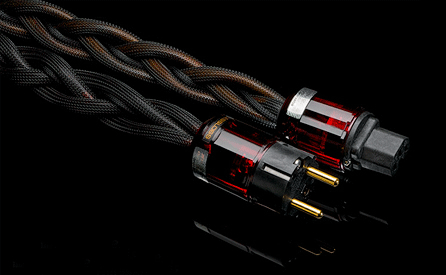
“The complexity, the inconceivable nature of nature.”
– Richard Feynman
Those of you who have read my review of the LessLoss Dynamic Filtering Power Cord (now called the DFPC Original, to distinguish it from the DFPC Signature) may recall my description of the compelling improvements it made over OEM cords. For years firm in the conviction that a power cord cannot possibly make a real difference in the sound – unless it was improperly or inadequately constructed in the first place – I was astonished and delighted at how wrong I had been. But I don’t think LessLoss are your average audiophile cord. There’s reasoning behind its design that makes good sense. (And in the world of high-end audio, this is not always the case.) As well, there is a body of quantum physical theory, as well as years of experimentation, behind the design. Indeed, the LessLoss site has a link to Richard Feynman’s Auckland lectures on QED, quantum electrodynamics. (I believe Feynman is the guy who said that anyone who claims to understand quantum mechanics doesn’t. However simplified Feynman’s presentations in these lectures may be, I find QED conceptually daunting. Perhaps after a second and third perusal…) In my review I described the DFPC Original on a simplified level, as exploiting skin effect by means of proprietary wire treatment to filter high frequency noise. Accurate as far as it went. But with the Signature the theoretical underpinning proliferates.
Wishing to redetermine the very best AC connectors to use with their new wire, LessLoss did extensive listening tests of various connectors from Furutech, Wattgate, Oyaide and other manufacturers and chose Oyaide as by far the best sounding. They did further testing of several top Oyaide models, the 079, 004 and the ridiculously expensive M1/F1 (which they found to sound pretty much the same as the far less expensive 004). Details of these tests are on the LessLoss site and are interesting both in their findings and in their reflections on the auditioning process itself. Based on this empirical testing they decided to continue the Original’s use of the Oyaide 079 in the Signature.
In fact, externally the Signature looks like the Original with an additional, thinner (2.5mm) wire woven into the braid. The Original has three thick (6mm) wires, one for phase, one for neutral, one for ground. But in the Signature two of the thick wires are paralleled to constitute the phase side of the AC. The remaining thick wire is the neutral side. And the fourth, thinner wire is ground. This arrangement increases filtering over the Original without effecting the overall current capacity of the cord. As noted in my previous review, 6mm wires fall between 9 and 10 gauge for a current rating between 19 and 15 amperes. Enough current to sustain reproducing an organ pedal at 1800 watts. There may be amplifiers able to generate that much raw power, but I doubt any loudspeaker could handle it for more than a few milliseconds. And this is a conservative transmission line ampacity; 10 AWG wire has an open air ampacity of 55 amperes.
Thirty plus years ago, I was in a high-end store in North Pasadena (only a couple of miles from Professor Feynman’s office at Cal Tech) buying a pair of KEF101s, and serendipitously I met Richard Heyser of AES and time delay spectrometry fame. Richard, who was employed at Jet Propulsion Laboratory, was a natural born teacher and since I’m something of a natural born questioner, we hit it off. I must have asked him something about quantum physics because over the next half hour he explained the relationship between loudspeaker cones and quantum mechanics. Even more unlikely than the juxtaposition of these two topics was the fact that, for awhile at least, I actually understood. I left the store in an altered state of mind. Quantum electrodynamic theory, which lies elusively behind the design of the LessLess Signature, reminds me of that experience. The way physical reality behaves at a quantum level is the way it really behaves, however strange, unlikely, incomprehensible, illogical, or crazy it may seem, as Professor Feynman points out.
When I asked Louis Motek, the owner/designer of LessLoss, about the wire gauge of the Signatures compared to the Originals, he sent the following fascinating response: “Depends on how you consider electrical flow. If you consider that electricity flows due to photon-electron interactions, then the gauge of the three large wires in the Signature is larger [than the Original]. If you think electrons flow through wire without photon-electron interaction, then they are the same.” This distinction has to do with the differences in the treatments given the wires. It is not about ampacity; both cords have the same current capacity; it is about what electrons “see” and how they behave as they propagate. Further, “If you think in [terms of photon-electron interaction], nothing else happens, except that you can incorporate this into your design solution. This is in no way something that makes copper conduct more current and it is not a measurable difference. Yet we hear it.”
In hope of better understanding how the DFPC Signature may work, I have been watching Feynman’s Auckland lectures (http://vega.org.uk/video/subseries/8). And rather than qualifying every single statement in the following paragraph with “it is my understanding,” I’d like to qualify the entire paragraph. Or, as they might say in Monty Python’s Flying Circus, and now for something completely speculative.
I woke this morning thinking about Feynman’s diagrams of electron-photon interactions. Photons are to be understood as the constituent of electromagnetic radiation, and the term light is not limited to the visible spectrum. The simplest of these diagrams consists of an single electron path through time. At various points a photon is absorbed by or emitted from the electron. These points are called a junctions, and the electron, which has mass but no dimension, changes direction at these junctions. Junctions are normative, except in a lightless vacuum. So an electron doesn’t actually “go” from point A to point B, but rather there is a probability that an electron at A interacting with – generating and receiving – photons, traveling hither and yon in the process, will appear at B. For all I know there are millions of these junctions occurring every inch an electron travels. It is not a straight path. It is not like lining up a row of billiard balls. It is a complex network of events that operate on laws of probability. Which means that some of the electrons will never get to B from A. Could it be that one result of this incalculably complex physical process is what we audiophiles callnoise? Based on these speculations, I tend to think of the increased “electron-photon gauge” (to coin a phrase) of Signature wire as giving more “elbow room” for the propagation of electrons, thus generating less noise. My speculations could all, of course, be nonsense. However, the basic idea that ‘electrons moving through a conductor’ generate noise is not nonsense. Ask Jack Bybee about quantum noise.
There is also the issue of external noise, noise coming in through the back door as it were. There must be a large quantity of energy of every imaginable frequency riding in on our AC power grid, as well as a large quantity of environmental radiation inducing noise in all conductors, from planetary (Schumann) radiation on up to high energy gigahertz particles traveling light years before alighting in one’s living room. The Signature skin treatment is designed to also limit this source of noise. Thinking about these properties of the wire put me in mind of Acoustic Revive’s passive approach to power filtering, which may have something in common with it. Of course AR use top quality components, a CNC machined chassis, special vibration damping feet, Oyaide connectors, and so forth. But fundamentally the AC enters through a male IEC connector and travels a few inches of wire to female AC receptacles. In the bottom of this chassis is potted carborundum, tourmaline and quartz. The theory being that this environment absorbs and dissipates unwanted electromagnetic energy. I’ve reviewed this device and Clement Perry has mentioned it as one of the best power conditioners he’s heard. I expect that Ken Ishiguro, the brains behind Acoustic Revive, arrived at his designs much the same way as Louis Motek, through creativity, experimentation, analysis, and more experimentation. And I suspect also that some of the same things that are going on in the Acoustic Revive conditioner are going on in the Signature cord.
Signature wires receive the same skin treatment as the Original and then get additional treatments that contribute, in Mr. Motek’s words,“…overlapping high frequency absorbance and reflectance spectra to maximize this high frequency noise suppressing faculty. The result is not simply a “poorly conductive” skin, but one which combines poor conduction with refined and highly tuned high frequency spectrum manipulation to inhibit electronic noise…” I was curious how these theoretical descriptions were arrived at. And in particular I found one especially provocative, which provides the raison d’être for filtering very high frequencies: “Noise always works from the top down.” First off, the harmonics of 60Hz (or 50Hz) are excluded from this statement. These are naturally occurring artifacts of the untuned transmission lines and transformers that deliver alternating current to our homes. Rather, this statement is a conclusion based on the empirical process in which the suppression of high frequency noise was found to have a beneficial audible effect.
Since I figured the Signature is generally based on the same technology as the Original, I expected that any audible improvement would be incremental. Yes and no. The relative degree of improvement is not as great as that of the Original over OEM cords, which was literally mind boggling. Howbeit, the Signature is patently superior to the Original in every way. As the capacity of a stereo system opens up and gets more and more pellucid, one’s core experience – the illusion of real instruments and singers in your living room – is enhanced. Worth the price difference ($1149 vs. $595)? I think it is. Of course, I have compared the Signature with only the Original; I cannot say how it compares to other cords in its price range. I can say that the improvements I heard over the Original were compelling and, at times, thrilling.
Mr. Motek emailed an anecdote about a sound engineer and studio owner from Riga (whom he described as experienced, knowledgeable, intelligent, and intellectually critical) who visited LessLoss in Kaunas to audition power cords. He and his guest compared the Signature to some other well-known cords – Shunyata, Nordost Valhalla, Neotech – repeatedly switching back and forth among them using various recordings, then finally staying with the Signatures. The visiting engineer was very impressed. In some astonishment he said, “That’sa grand piano” and “That’s an orchestra.” A few days later he placed an order for 49 Signature cords.
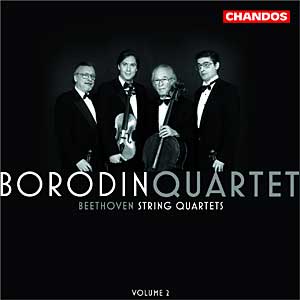 Beethoven Opus 74, “Harp Quartet” (Chandos 10191, Borodin SQ). Despite my deep familiarity with every nook and cranny of this recording, I heard a passage in the ‘cello with absolute distinctness that I’ve never even noticed before. In fact, throughout this quartet and others in the Borodin series, the violoncello has a new clarity and prominence. It is not just more distinct, it has more body, harmonic richness and dimensionality. Quite uncanny in a way. It made we want to say, “Now that’s a ‘cello.” Individual instruments are less “blended” constituting a more detailed and individuated texture. Comparing the Original to the Signature using quantitative language for an essentially qualitative distinction, it is rather like looking at a distant scene with 20/30 eyes – eyes that can perceive much detail and beauty – and then putting on corrective lenses and viewing the same scene with 20/20 eyes. Details you didn’t even know were there become apparent.
Beethoven Opus 74, “Harp Quartet” (Chandos 10191, Borodin SQ). Despite my deep familiarity with every nook and cranny of this recording, I heard a passage in the ‘cello with absolute distinctness that I’ve never even noticed before. In fact, throughout this quartet and others in the Borodin series, the violoncello has a new clarity and prominence. It is not just more distinct, it has more body, harmonic richness and dimensionality. Quite uncanny in a way. It made we want to say, “Now that’s a ‘cello.” Individual instruments are less “blended” constituting a more detailed and individuated texture. Comparing the Original to the Signature using quantitative language for an essentially qualitative distinction, it is rather like looking at a distant scene with 20/30 eyes – eyes that can perceive much detail and beauty – and then putting on corrective lenses and viewing the same scene with 20/20 eyes. Details you didn’t even know were there become apparent.
Beethoven, Opus 28, “Pastoral” Sonata (ABC 465 695-2, Gerard Willems). This seems to me the most impressive rendering of the Stuart & Sons piano I have heard. It was late at night, I felt relaxed and unpressured. Once again I am forced to use that word presence, much as I’d like to accurately distinguish its use here from the other times I’ve used it. Or to say something fanciful like, “On a presence scale of zero to ten, I give it a nine.” What, after all, constitutes presence? Detail that enables one to “see” the instrument, hearing the environment not merely of the hall in which the instrument was recorded, but the environment inside the instrument, the vanishingly fine reverberations, sympathetic vibrations and dampening taking place inside the piano itself, those little stereophonic clues as to position and dimension? Once again I get the impression that these leaps in realism are not a matter of information retrieval so much as a matter of noise removal. Obviously these nuances are physically present in the media regardless of the AC cord used, and reasonably good equipment is capable of reproducing them. But with a great power cord they shed their cloak of ambiguity and reticence. The better the cord, the more obvious they become. I returned to this series of CDs the next day and played Beethoven’s last sonata, Opus 111. No, it wasn’t as I had suspected simply the magic of the ambiance of late evening at day’s end, the relaxed, darkened room, and the cappuccino. In the clear light of morning with a day’s work ahead of me, I found the reproduction of the piano again stunningly realistic.
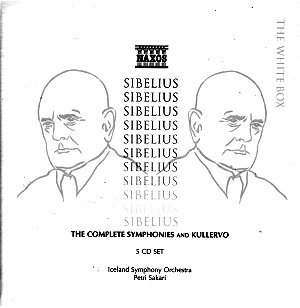 Sibelius’s Second Symphony(Naxos 8.505179, Icelandic SO, Petri Sakari). I have never been less aware of the presence of loudspeakers with large-scale music, never has the orchestra been so transparently and obviously “present” in the room, and never have the walls of the room so completely disappeared. I especially noted the tactile quality of the raspy bite of the brass, the fullness of the double basses, the clear sense of image depth. Turning up the bass tone control (if I had one) would not achieve these effects, which are not about quantity but quality. Emphatically, power cords do not change measured amplifier specifications like frequency response, rather they enable amplifiers (and other equipment) to operate closer to their potential. (It would be interesting to compare the sound of a system powered with batteries, to the same system powered with alternating current through Acoustic Revive’s cord/conditioner, and LessLoss’s Signature cords.)
Sibelius’s Second Symphony(Naxos 8.505179, Icelandic SO, Petri Sakari). I have never been less aware of the presence of loudspeakers with large-scale music, never has the orchestra been so transparently and obviously “present” in the room, and never have the walls of the room so completely disappeared. I especially noted the tactile quality of the raspy bite of the brass, the fullness of the double basses, the clear sense of image depth. Turning up the bass tone control (if I had one) would not achieve these effects, which are not about quantity but quality. Emphatically, power cords do not change measured amplifier specifications like frequency response, rather they enable amplifiers (and other equipment) to operate closer to their potential. (It would be interesting to compare the sound of a system powered with batteries, to the same system powered with alternating current through Acoustic Revive’s cord/conditioner, and LessLoss’s Signature cords.)
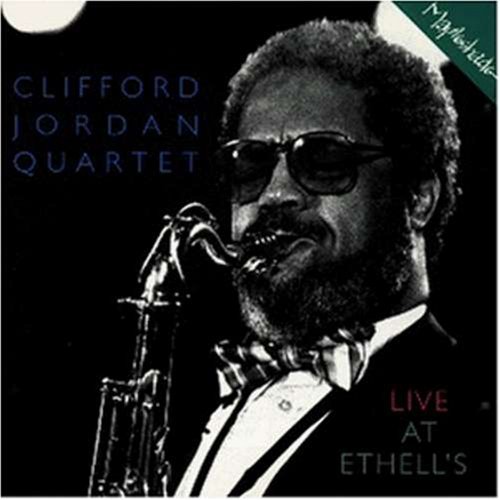 In the middle of the third cut, ‘Round Midnight, fromLive At Ethell’s (Mapleshade 56292, Clifford Jordan Quartet) some joker yells out, probably for another scotch. This time it took me by surprise. And as I was in another room, I spun around to see if the window behind me was open and some guy was yelling in the back yard. This is not the first time I’ve heard this cut from this room, but it’s the first time it’s fooled me. I think this has to do with the ability of the Signatures to enable very fine ambient information to be rendered: the acoustical space around the musicians soundsdifferent than the acoustical space around the audience. Since I was not in the living room in front of the loudspeakers, these spatial clues created the illusion the sound came from behind the band. This masterful recording from Mapleshade sounds amazingly life-like with the Originals, but even more so with the Signatures.
In the middle of the third cut, ‘Round Midnight, fromLive At Ethell’s (Mapleshade 56292, Clifford Jordan Quartet) some joker yells out, probably for another scotch. This time it took me by surprise. And as I was in another room, I spun around to see if the window behind me was open and some guy was yelling in the back yard. This is not the first time I’ve heard this cut from this room, but it’s the first time it’s fooled me. I think this has to do with the ability of the Signatures to enable very fine ambient information to be rendered: the acoustical space around the musicians soundsdifferent than the acoustical space around the audience. Since I was not in the living room in front of the loudspeakers, these spatial clues created the illusion the sound came from behind the band. This masterful recording from Mapleshade sounds amazingly life-like with the Originals, but even more so with the Signatures.
The other day a friend stopped by who’s interested in audio, loves music enough to have recently spent seven or eight grand on wires, loudspeakers and electronics, and, as far as I can tell, has significantly better ears than yours truly. She’s quite familiar with the sound of my stereo with the LessLoss Originals (although she’s not given it a serious audition since the Spike Sound Will feet were installed a few weeks ago) and I value her perceptions. Rather than going for one of my favorite “test” CDs, I randomly chose one. It was Beethoven’s Fifth Piano Concerto with Krystian Zimerman and the Vienna Philharmonic, an older analog reissue with (I think) Leonard Bernstein conducting. I had not thought of this CD as having particularly wonderful sound. But I’ve never seen her so captivated and so effusive in her praise and description of the sound. She spoke of the walls of the living room disappearing to incorporate a huge sound stage, the visceral feel of the tympani in her chest, the specificity of the piano and her sense of surprise when the orchestra “appeared” behind the piano.
As I’ve said before, one doesn’t normally think of a power cord as offering equal or greater improvements to the sound than a new DAC or preamplifier, or a multi-thousand dollar set of interconnect cords. But I would urge you to consider the possibility. LessLoss cords come with a 30 day money back guarantee.

![]()
Physical features:
* Oyaide model 079 double hand polished, twice gold plated high performance power plugs from Japan
* Oyaide Model C-279 20A IEC plug available
* Very flexible design: tight bend radius only 7 inches
* LessLoss proprietary FlowFlux TM Technology
* Total cross sectional conductive area is 20.5 mm2 (~4 AWG)
Price: $1149.00ea
LessLoss Audio Devices
P.D. 1231
46005 Kaunas
Lithuania
Tel.: +370 698 48706
email: info@lessloss.com
web info and store: www.LessLoss.com
![]()
Don’t forget to bookmark us! (CTRL-SHFT-D)
Stereo Times Masthead
Publisher/Founder
Clement Perry
Editor
Dave Thomas
Senior Editors
Frank Alles, Mike Girardi, Russell Lichter, Terry London, Moreno Mitchell, Paul Szabady, Bill Wells, Mike Wright, and Stephen Yan,
Current Contributors
David Abramson, Tim Barrall, Dave Allison, Ron Cook, Lewis Dardick, John Hoffman, Dan Secula, Don Shaulis, Greg Simmons, Eric Teh, Greg Voth, Richard Willie, Ed Van Winkle, Rob Dockery, Richard Doron, and Daveed Turek
Site Management Clement Perry
Ad Designer: Martin Perry



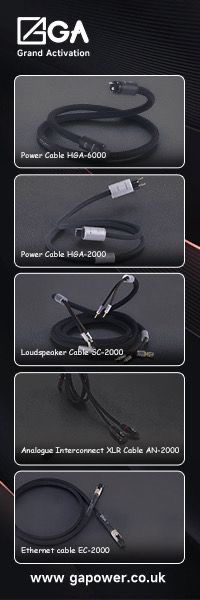

Be the first to comment on: LessLoss DFPC Signature